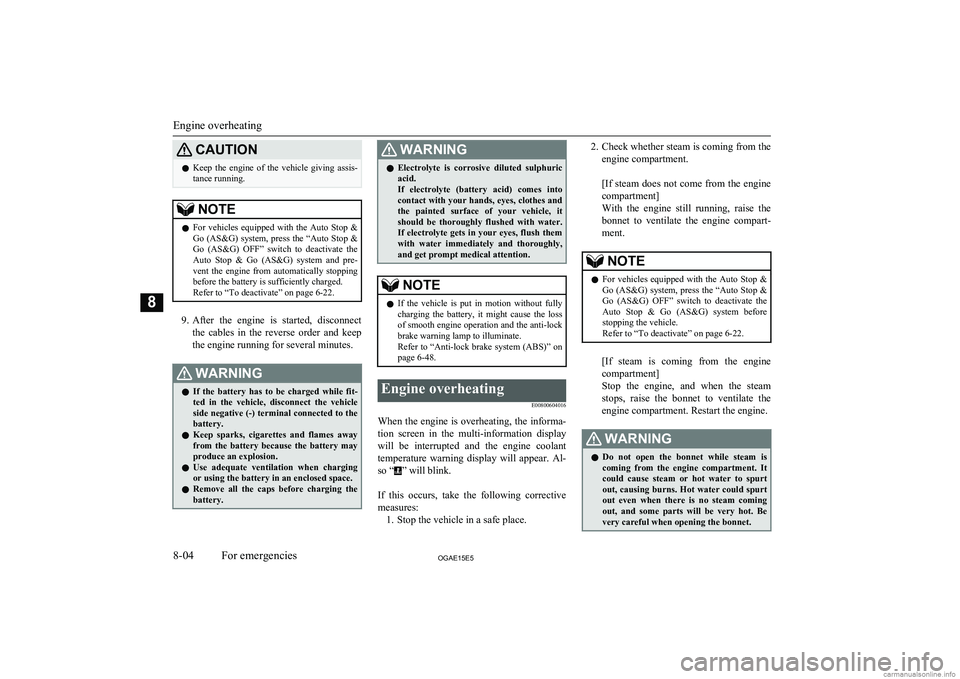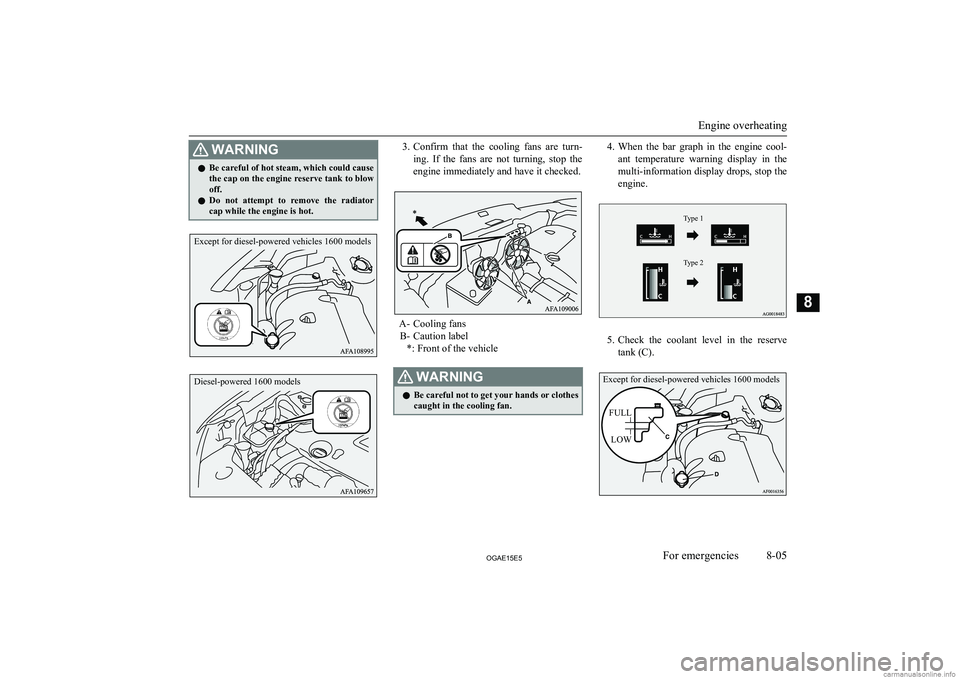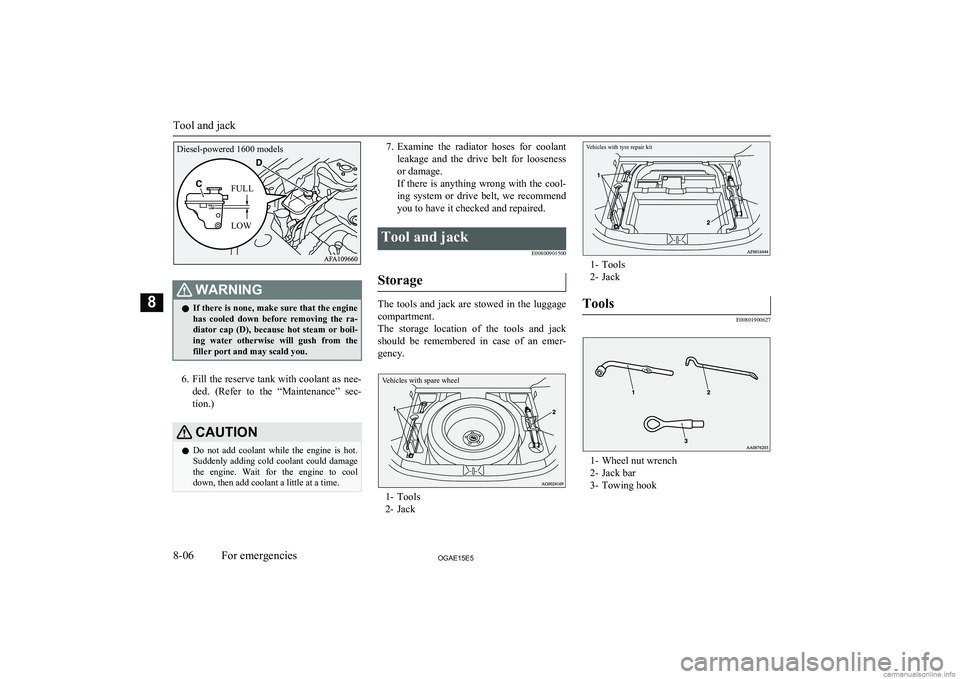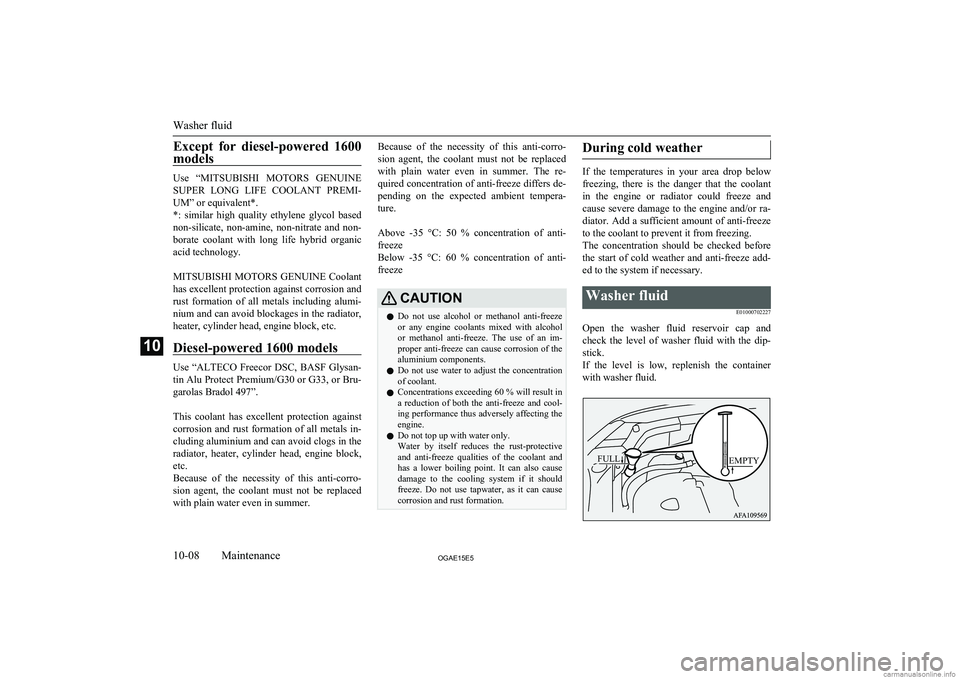engine coolant MITSUBISHI ASX 2015 (in English) User Guide
[x] Cancel search | Manufacturer: MITSUBISHI, Model Year: 2015, Model line: ASX, Model: MITSUBISHI ASX 2015Pages: 452, PDF Size: 20.1 MB
Page 247 of 452

NOTElWhile the engine coolant temperature is low,
the temperature of the air from the heaterwill be cool/cold until the engine warms up, even if you have selected warm air with the
dial.
l On vehicles with the automatic air condi-
tioning, when the temperature is set to the highest or the lowest setting under the AU-
TO operation, the air selection and the air
conditioning will be automatically changed as follows.
• Quick Heating (When the temperature is
set to the highest setting)
Outside air will be introduced and the air
conditioning will stop.
• Quick Cooling (When the temperature is
set to the lowest setting)
Inside air will be recirculated and the air
conditioning will operate.
The settings described above are the factory
settings. The air selection and air condition-
ing switches can be customized (function set-
ting changed), and the automatic switching of outside air and the air conditioning according
to operating conditions can be changed as de- sired.
For further information, we recommend you to consult a MITSUBISHI MOTORS Au-
thorized Service Point.
Refer to “Customizing the air conditioning
switch (Automatic air conditioning)” on page 7-07.
Refer to “Customizing the air selection” on
page 7-06.Air selection switch
E00701300721
To change the air selection, simply press theair selection switch. There is a sound each
time the switch is pressed.
l Outside air: Indication lamp (A) is OFF
Outside air is introduced into the passen-
ger compartment.
l Recirculated air: Indication lamp (A) is
ON
Air is recirculated inside the passenger
compartment.
Heater/
Manual air conditioningAutomatic air conditioning
CAUTIONl Normally, use the outside position to keep
the windscreen and side windows clear and quickly remove fog or frost from the wind- screen.
If high cooling performance is desired, or if
the outside air is dusty or otherwise contami- nated use the recirculation position. Switch
to the outside position periodically to in- crease ventilation so that the windows do notbecome fogged up.
l Use of the recirculation position for exten-
ded time may cause the windows to fog up.NOTEl On vehicles with the heater and the manual
air conditioning, when the system operateswith the selection switch in the outside posi- tion, the system automatically determines
whether to continue using outside air or to
perform recirculation. If the outside air tem-
perature is high, the system selects recircula- tion and causes the indication lamp (A) in
the switch to illuminate (for vehicles with the manual air conditioning, the system se-
lects recirculation to achieve rapid cooling). Press the selection switch to return to out-
side air introduction.
Heater/Air conditioning
7-05OGAE15E5For pleasant driving7
Page 248 of 452

NOTElOn vehicles with the automatic air condi-
tioning, when the mode selection dial or the
blower speed selection dial is set to the “AUTO” position again after manual opera-tion, the air selection dial will also be auto- matically controlled.
l On vehicles with the automatic air condi-
tioning, when the engine coolant tempera-
ture rises to a certain level, the air selection is automatically switched to the recirculation
position and the indication lamp (A) comes on. At this time, the system will not switch
to the outside position even if the air selec-
tion switch is pushed.Customizing the air selection
E00732500107
Functions can be changed as desired, as sta-
ted below.
l Enable automatic air control
• Heater/Manual air conditioning: When the system operates, the air se-
lection switch will be automatically controlled.
• Automatic air conditioning: When the mode selection dial or
blower speed selection dial is turned
to the “AUTO” position, the air selec-
tion switch is also controlled automat- ically.
l Disable automatic air control
• Heater/Manual air conditioning:
Even when the system operates, theair selection switch will not be auto-
matically controlled.
• Automatic air conditioning: Even when the mode selection dial orblower speed selection dial is turned
to the “AUTO” position, the air selec-
tion switch is not controlled automati- cally.
l Setting change method
Hold down the air selection switch for about 10 seconds or more.
When the setting is changed, a sound is
emitted and the indication lamp flashes. • When the setting is changed from ena-
ble to disable 3 sounds are emitted and
the indication lamp flashes 3 times.
• When the setting is changed from dis-
able to enable 2 sounds are emitted and the indication lamp flashes 3times.NOTEl The factory setting is “Enable automatic air
control.”
l When the mode selection dial is turned to
“
”, in order to prevent misting of the
windows the ventilator automatically switches to outside air even if “Disable auto-matic air control” is set.
Air conditioning switch (Air
conditioning)
E00701501052
Push the switch to turn the air conditioning
on, indication lamp (A) will come on.
There is a sound each time the switch is pressed.
Manual air conditioningAutomatic air conditioning
Push the switch again to switch it off.
CAUTIONl When using the air conditioning, the idling
speed may slightly increase as the air condi-
tioning compressor is switched on/off auto- matically. While the vehicle with an A/T or
CVT is stationary, fully depress the brake pedal to prevent the vehicle from creeping.
Heater/Air conditioning
7-06OGAE15E5For pleasant driving7
Page 251 of 452

Automatic mode (Automatic airconditioning)
E00764801113
In normal conditions, use the system in the
AUTO mode and follow these procedures: 1. Set the blower speed selection dial to the
“AUTO” position.
2. Set the temperature control dial to the
desired temperature.
3. Set the mode selection dial to the “AU-
TO” position.
The outlet position recirculation/outside air
select and blower speed, and ON/OFF of the air conditioning will be controlled automati-cally.
To stop the system, turn the blower speed se- lection dial to the “OFF” position.
CAUTIONl When using the air conditioning, the idling
speed may slightly increase as the air condi-
tioning compressor is switched on/off auto- matically. While the vehicle with an A/T or
CVT is stationary, fully depress the brake pedal to prevent the vehicle from creeping.NOTEl While the engine coolant temperature is low,
the temperature of the air from the heaterwill be cool/cold until the engine warms up, even if you have selected warm air with the
dial. To prevent the windscreen and win-
dows from fogging up, the ventilator mode
will be changed to “
” and the blower
speed will be reduced.
l If the blower speed selection dial, air condi-
tioning switch, mode selection dial, or air se-
lection switch is operated while the system is operating in the AUTO mode, the activa-ted function overrides the corresponding
function of automatic control. All other
functions remain under automatic control.
Manual mode (Automatic air
conditioning)
E00764900032
Blower speed and ventilator mode may be
controlled manually by setting the blower speed selection dial and the mode selection
dial to the desired positions. To return to au-
tomatic operation, set the dials to the “AU- TO” position.
Demisting of the windscreen
and door windows
E00702100768
CAUTIONl For safety, make sure you have a clear view
through all the windows.
Use the mode selection dial (“” or “”)
to remove frost or mist from the windscreen or door windows.
Heater/Air conditioning
7-09OGAE15E5For pleasant driving7
Page 330 of 452

CAUTIONlKeep the engine of the vehicle giving assis-
tance running.NOTEl For vehicles equipped with the Auto Stop &
Go (AS&G) system, press the “Auto Stop &Go (AS&G) OFF” switch to deactivate theAuto Stop & Go (AS&G) system and pre- vent the engine from automatically stoppingbefore the battery is sufficiently charged.Refer to “To deactivate” on page 6-22.
9. After the engine is started, disconnect
the cables in the reverse order and keep the engine running for several minutes.
WARNINGl If the battery has to be charged while fit-
ted in the vehicle, disconnect the vehicle side negative (-) terminal connected to the
battery.
l Keep sparks, cigarettes and flames away
from the battery because the battery may produce an explosion.
l Use adequate ventilation when charging
or using the battery in an enclosed space.
l Remove all the caps before charging the
battery.WARNINGl Electrolyte is corrosive diluted sulphuric
acid.
If electrolyte (battery acid) comes into contact with your hands, eyes, clothes and
the painted surface of your vehicle, it should be thoroughly flushed with water.If electrolyte gets in your eyes, flush them
with water immediately and thoroughly, and get prompt medical attention.NOTEl If the vehicle is put in motion without fully
charging the battery, it might cause the loss
of smooth engine operation and the anti-lock brake warning lamp to illuminate.
Refer to “Anti-lock brake system (ABS)” on
page 6-48.Engine overheating
E00800604016
When the engine is overheating, the informa-tion screen in the multi-information display
will be interrupted and the engine coolant
temperature warning display will appear. Al- so “
” will blink.
If this occurs, take the following corrective measures: 1. Stop the vehicle in a safe place.
2. Check whether steam is coming from the
engine compartment.
[If steam does not come from the engine
compartment]
With the engine still running, raise the
bonnet to ventilate the engine compart-
ment.NOTEl For vehicles equipped with the Auto Stop &
Go (AS&G) system, press the “Auto Stop &Go (AS&G) OFF” switch to deactivate theAuto Stop & Go (AS&G) system before stopping the vehicle.
Refer to “To deactivate” on page 6-22.
[If steam is coming from the engine
compartment]
Stop the engine, and when the steam
stops, raise the bonnet to ventilate the engine compartment. Restart the engine.
WARNINGl Do not open the bonnet while steam is
coming from the engine compartment. It
could cause steam or hot water to spurt out, causing burns. Hot water could spurt
out even when there is no steam coming out, and some parts will be very hot. Be
very careful when opening the bonnet.
Engine overheating
8-04OGAE15E5For emergencies8
Page 331 of 452

WARNINGlBe careful of hot steam, which could cause
the cap on the engine reserve tank to blow off.
l Do not attempt to remove the radiator
cap while the engine is hot.3. Confirm that the cooling fans are turn-
ing. If the fans are not turning, stop the
engine immediately and have it checked.
A- Cooling fans B- Caution label *: Front of the vehicle
WARNINGl Be careful not to get your hands or clothes
caught in the cooling fan.4. When the bar graph in the engine cool-
ant temperature warning display in the
multi-information display drops, stop the
engine.Type 1Type 2Type 1Type 2
5. Check the coolant level in the reserve
tank (C).
Engine overheating
8-05OGAE15E5For emergencies8 Except for diesel-powered vehicles 1600 models Diesel-powered 1600 models Except for diesel-powered vehicles 1600 modelsFULLLOW
Page 332 of 452

WARNINGlIf there is none, make sure that the engine
has cooled down before removing the ra-
diator cap (D), because hot steam or boil- ing water otherwise will gush from the filler port and may scald you.
6. Fill the reserve tank with coolant as nee-
ded. (Refer to the “Maintenance” sec- tion.)
CAUTIONl Do not add coolant while the engine is hot.
Suddenly adding cold coolant could damage
the engine. Wait for the engine to cool
down, then add coolant a little at a time.7. Examine the radiator hoses for coolant
leakage and the drive belt for looseness
or damage.
If there is anything wrong with the cool-
ing system or drive belt, we recommend
you to have it checked and repaired.Tool and jack
E00800901500
Storage
The tools and jack are stowed in the luggagecompartment.
The storage location of the tools and jack should be remembered in case of an emer-
gency.
Vehicles with spare wheel
1- Tools
2- Jack
1- Tools
2- Jack
Tools
E00801900627
1- Wheel nut wrench
2- Jack bar
3- Towing hook
Tool and jack
8-06OGAE15E5For emergencies8Diesel-powered 1600 modelsFULL
LOW Vehicles with tyre repair kit
Page 359 of 452

Service precautions........................................................................... 10-02
Catalytic converter............................................................................ 10-02
Bonnet............................................................................................... 10-03
Engine oil.......................................................................................... 10-05 Engine coolant...................................................................................10-07
Washer fluid...................................................................................... 10-08
Brake fluid/Clutch fluid*.................................................................. 10-09
Battery............................................................................................... 10-09 Tyres..................................................................................................10-13Wiper blade rubber replacement....................................................... 10-17
General maintenance......................................................................... 10-19
For cold and snowy weather............................................................. 10-19
Fusible links...................................................................................... 10-19
Fuses..................................................................................................10-20
Replacement of lamp bulbs............................................................... 10-26Maintenance
OGAE15E510
Page 365 of 452

lUse engine oil conforming to the follow-
ing classification: • ACEA classification: “For service C1, C2, C3 or C4”
• JASO classification: “For service DL-1”
If those classifications are not available,
contact a MITSUBISHI MOTORS Au-
thorized Service Point.NOTEl Use of additives is not recommended since
they may reduce the effectiveness of addi-
tives already included in the engine oil. It may result in failure of the mechanical as-
sembly.Engine coolant
E01000503437
To check the coolant level
A transparent coolant reserve tank (A) is lo-cated in the engine compartment.
The coolant level in this tank should be kept
between the “LOW” and “FULL” marks when measured while the engine is cold.To add coolant
The cooling system is a closed system andnormally the loss of coolant should be very
slight. A noticeable drop in the coolant level
could indicate leakage. If this occurs, we rec- ommend you to have the system checked as
soon as possible.
If the level should drop below the “LOW” level on the reserve tank, open the lid and
add coolant.
Also, if the reserve tank is completely empty, remove the radiator cap (B) and add coolant until the level reaches the filler neck.
WARNINGl Do not open the radiator cap (B) while the
engine is hot. The coolant system is under
pressure and any hot coolant escaping
could cause severe burns.
Anti-freeze
The engine coolant contains an ethylene gly-
col anti-corrosion agent. Some parts of the engine are cast aluminium alloy, and periodic
changing of the engine coolant is necessary to prevent corrosion of these parts.
Engine coolant
10-07OGAE15E5Maintenance10 Except for diesel-powered vehicles 1600 models
FULLLOW Diesel-powered vehicles 1600 modelsFULLLOW
Page 366 of 452

Except for diesel-powered 1600models
Use “ MITSUBISHI MOTORS GENUINE
SUPER LONG LIFE COOLANT PREMI-
UM” or equivalent*.
*: similar high quality ethylene glycol based
non-silicate, non-amine, non-nitrate and non- borate coolant with long life hybrid organic acid technology.
MITSUBISHI MOTORS GENUINE Coolant
has excellent protection against corrosion and rust formation of all metals including alumi-
nium and can avoid blockages in the radiator,
heater, cylinder head, engine block, etc.
Diesel-powered 1600 models
Use “ALTECO Freecor DSC, BASF Glysan- tin Alu Protect Premium/G30 or G33, or Bru-
garolas Bradol 497”.
This coolant has excellent protection against
corrosion and rust formation of all metals in-
cluding aluminium and can avoid clogs in the
radiator, heater, cylinder head, engine block,
etc.
Because of the necessity of this anti-corro-
sion agent, the coolant must not be replaced with plain water even in summer.
Because of the necessity of this anti-corro-
sion agent, the coolant must not be replaced with plain water even in summer. The re-
quired concentration of anti-freeze differs de-
pending on the expected ambient tempera- ture.
Above -35 °C: 50 % concentration of anti-
freeze
Below -35 °C: 60 % concentration of anti-
freezeCAUTIONl Do not use alcohol or methanol anti-freeze
or any engine coolants mixed with alcohol or methanol anti-freeze. The use of an im-
proper anti-freeze can cause corrosion of the aluminium components.
l Do not use water to adjust the concentration
of coolant.
l Concentrations exceeding 60 % will result in
a reduction of both the anti-freeze and cool-
ing performance thus adversely affecting the engine.
l Do not top up with water only.
Water by itself reduces the rust-protective
and anti-freeze qualities of the coolant and has a lower boiling point. It can also causedamage to the cooling system if it should freeze. Do not use tapwater, as it can causecorrosion and rust formation.During cold weather
If the temperatures in your area drop below
freezing, there is the danger that the coolant
in the engine or radiator could freeze and cause severe damage to the engine and/or ra-diator. Add a sufficient amount of anti-freeze
to the coolant to prevent it from freezing. The concentration should be checked before the start of cold weather and anti-freeze add- ed to the system if necessary.
Washer fluid
E01000702227
Open the washer fluid reservoir cap andcheck the level of washer fluid with the dip- stick.
If the level is low, replenish the container with washer fluid.
Washer fluid
10-08OGAE15E5Maintenance10 FULLEMPTY
Page 377 of 452

General maintenanceE01002700520
Fuel, engine coolant, oil and ex- haust gas leakage
Look under the body of your vehicle to check
for fuel, engine coolant, oil and exhaust gas
leaks.
WARNINGl If you see a suspicious fuel leak or if you
smell fuel, do not operate the vehicle; call
your MITSUBISHI MOTORS Author-
ized Service Point for assistance.
Exterior and interior lamp op-
eration
Operate the combination lamp switch to
check that all lamps are functioning properly.
If the lamps do not illuminate, the probable cause is a blown fuse or defective lamp bulb.
Check the fuses first. If there is no blown
fuse, check the lamp bulbs.
For information regarding the inspection and
replacement of the fuses and the lamp bulbs, refer to “Fuses” on page 10-20 and “Re-
placement of lamp bulbs” on page 10-26.
If the fuses and bulbs are all OK, we recom-
mend you to have your vehicle checked and
repaired.
Meter, gauge and indicator/warning lamps operation
Start the engine and check the operation of all instruments, gauges and indication andwarning lamps.
If there is anything wrong, we recommend you to have your vehicle inspected.
Hinges and latches lubrication
Check all latches and hinges, and, if necessa- ry, have them lubricated.
For cold and snowy weather
E01002800361
Ventilation slots
The ventilation slots in front of the wind-
screen should be kept clear of leaves or brushed clear after heavy snowfall, so that
the operation of the heating and ventilation
systems will not be impaired.
Weatherstripping
To prevent freezing of the weatherstripping
on the doors, bonnet, etc., they should be treated with silicone grease.
Additional equipment
It is a good idea to carry a shovel or a short-
handled spade in the vehicle during the win- ter so that you can clear away snow if you get stranded. A small hand-brush for sweeping
snow off the vehicle and a plastic scraper for the windscreen and rear window are also use-ful.
Fusible links
E01002900564
The fusible links will melt to prevent a fire if
a large current attempts to flow through cer- tain electrical systems.
In case of a melted fusible link, we recom- mend you to have your vehicle inspected.
For the fusible links, please refer to “Fuse
load capacity” on page 10-22.
General maintenance
10-19OGAE15E5Maintenance10